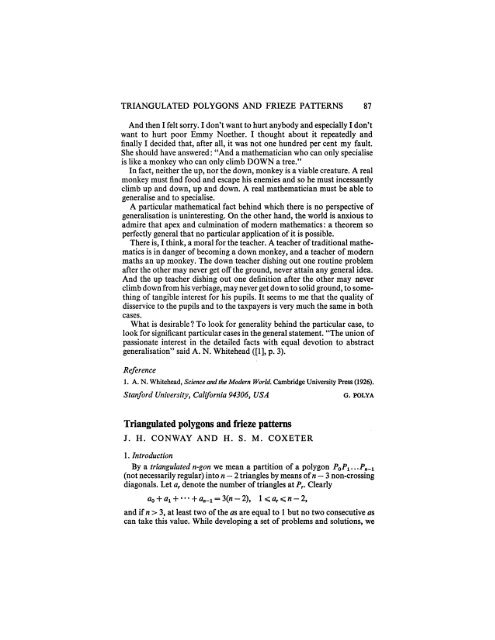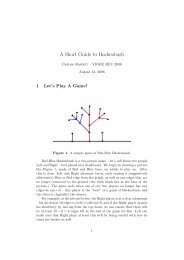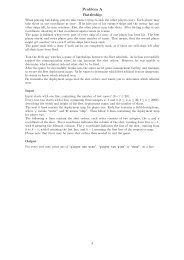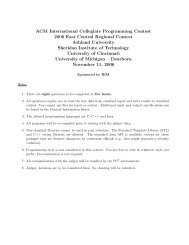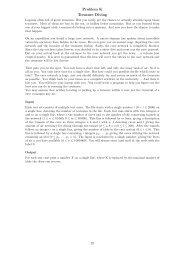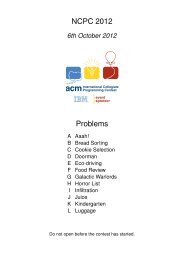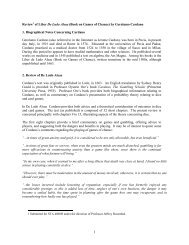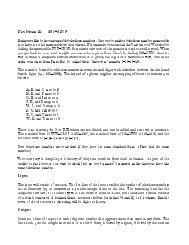Triangulated polygons and frieze patterns ... - Link home page
Triangulated polygons and frieze patterns ... - Link home page
Triangulated polygons and frieze patterns ... - Link home page
Create successful ePaper yourself
Turn your PDF publications into a flip-book with our unique Google optimized e-Paper software.
92 THE MATHEMATICAL GAZETTE(19) The unimodularule tells us thatalr-1 >01 a,except when every a, = 1. What analogous inequalities hold for sequencesof three or more as ?(20) What equation relates ao, a, ..., a,_3 ?(21) In an obvious sense, the pattern (3) is ofperiodtwo, while (7) is of periodthree <strong>and</strong> (14) is of period one. We see from (9) <strong>and</strong> (14) that every pattern oforder five is of period one or five. Is it always true that a, = a ? In otherwords, does every pattern of order n have period n or a divisor of n ?(22) For which values of n is the period always strictly less than n ?(23) Suppose... t u v w ... is part of the second row (cycle of as) of a <strong>frieze</strong>pattern of order n. What happens if the cycle is changed so that this part isreplaced by ... t u + 11 v+ 1 w ... ?(24) What relation (involving addition <strong>and</strong> divisibility) must hold for anythree consecutive entries in a diagonal (such asf_1, f,, f.r+) if the pattern isto consist entirely of integers?3. Problems about triangulated <strong>polygons</strong>Let us now carefully consider the problem of finding all possible cycles ofintegers ar that yield <strong>frieze</strong> <strong>patterns</strong> of integers. Lacking any perfectlydescriptive name, we will call them quiddity cycles.(25) Does every quiddity cycle include at least one 1 ?(26) Can every quiddity cycle of order n + 1 be derived from one of order nby means of the rule described in (23)?(27) Applying rule (23) to the 'cycle' 0 0 of order two, we obtain 1 1 1 oforder three, then 1 2 1 2 of order four, 1 3 1 2 2 of order five,141222, 132132, 131313, 231231of order six, <strong>and</strong> so on. Have you seen such cycles in any other connection?(28) Is there just one <strong>frieze</strong> pattern of integers for each triangulated polygon ?(29) Is there just one triangulated polygon for each <strong>frieze</strong> pattern of integers ?
TRIANGULATED POLYGONS AND FRIEZE PATTERNS 93(30) Draw the triangulated enneagon corresponding to the <strong>frieze</strong> pattern(7). Why is this interesting when regarded as a graph?(31) Is the number of integral <strong>frieze</strong> <strong>patterns</strong> finite for each value of n ?(32) Let a <strong>frieze</strong> pattern of integers be bordered by two rows of Ps, thus:Po Pi P2 P3 ... Pn- Po P1 1 1 1 1 1 1 1 12 1 4 2 1 3 2 23 1 3 7 1 2 5 3 11 2 5 3 1 3 7 12 1 3 2 2 1 4 2 11 1 1 1 1 1 1 1P3 ... Pn-l PO PI P2 P3<strong>and</strong> let (r, s) denote the entry where a south-east diagonal P,P, meets anorth-east diagonal PPs,, or vice versa. What happens to the polygonPoP ...P,-I whenever (r, s) = 1 ?(33) Does the 'fundamental region'2 1 4 2 11 3 7 12 5 33 2(which is repeated upside down, between the upper <strong>and</strong> lower rows of ones)always contain just n - 3 ones <strong>and</strong> the same number of twos?(34) One simple way to triangulate a polygon is by means of diagonalsforming a zigzag. Does this yield a <strong>frieze</strong> pattern consisting entirely ofFibonacci numbers?(35) Can we go one step farther <strong>and</strong> assert that every<strong>frieze</strong>pattern of integerseither contains a 4 or consists entirely of Fibonacci numbers ?[Section 4 (Solutions) will appear in the next issue of the Gazette. Thereferences given below apply also to that section.]References1. J. B6hm, Zu Coxeters Integrationsmethode in gekriimmten Raumen, Math. Nachr.27, 179-214 (1964).2. W. G. Brown, Historical note on a recurrent combinatorial problem, Am. math.Mon. 72, 973-977 (1965).3. H. S. M. Coxeter, On Schlafli's generalization of Napier's Pentagramma Mirificum,Bull. Calcutta math. Soc. 28, 123-144 (1936).


